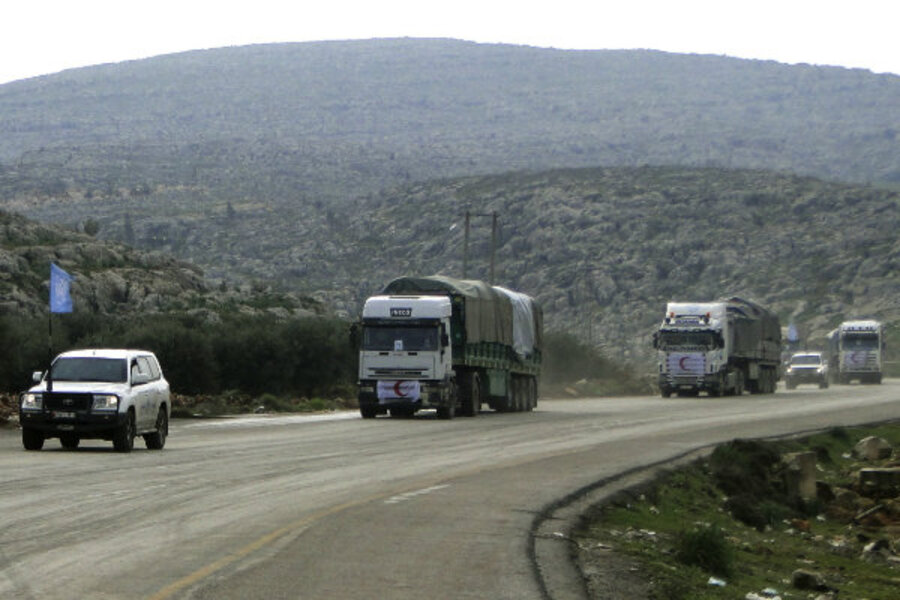Flexibility in US food aid to Syria should be the rule – not the exception
Loading...
| Washington
The Syria regional humanitarian crisis has affected 8.3 million people. Many require urgent food assistance, and the situation is worsening
But the food crisis for people in Syria – and for those who have fled – is not just a challenge of food availability. The conflict has brought a sharp drop in domestic food production, and many hungry people simply can no longer afford to buy food because prices are too high or their livelihoods have been wiped away by war. Millions have been forced to leave their homes, and food prices have skyrocketed, reportedly as much as 200 percent in some areas.
In crises like these, our organizations – CARE USA and Oxfam America – have learned that meeting humanitarian needs requires the flexibility to ensure good intentions result in positive outcomes. The United States is the largest donor for emergency food assistance in Syria. A substantial portion of that assistance has been provided through cash, vouchers, and by buying food locally and regionally through something called the Emergency Food Security Program.
While far more aid is still needed in Syria and the refugees in neighboring countries, the US government has been able to pursue a flexible approach in the country that better responds to needs on the ground. Yet such flexibility is the exception, not the rule, when it comes to US food aid programs. Instead, the vast majority of American food aid comes from another program altogether, one that is ensnared by red tape and regulations from another era.
The US government began purchasing American crops to export as food aid with the 1954 Agricultural Trade Development and Assistance Act. Sixty years later as every other facet of our society has evolved, this legislation still restricts how our aid programs can operate.
In April, President Obama’s budget proposed to bring food aid programs into the 21st century. These reforms end wasteful practices and eliminate programs that are saddled with outdated regulations. The changes would use the savings to boost programs like the Emergency Food Security program that have a proven track-record of success. And here’s the best part – they would allow the US to extend life-saving aid to up to 4 million more people without costing taxpayers one extra penny.
With hunger bound to arise as a topic of discussion at the G-8 Summit later this month, quicker and more flexible food aid can be a practical solution. In contrast, the current system requires that bulk commodities be bought from a limited group of preferred agribusiness corporations in the US, and then be shipped on preferred vessels before they are dispersed into local markets. Often these shipments compete with local and regional farmers, undermining long-term food security for the very people we aim to help.
US commodities designated as food aid often take three to five months to reach their destination. By comparison, local purchasing takes approximately 35 days. In times of crisis, this delay can be the difference between life and death.
America's generosity has saved hundreds of millions of people from starvation, but the system is broken and in desperate need of reform. Policymakers from both parties have known this for years. Several years ago, former President Bill Clinton apologized for exporting cheap American rice to Haiti: "It may have been good for some of my farmers in Arkansas, but it has not worked.”
A more prudent approach, as allowed by Mr. Obama’s proposed reforms, would allow aid agencies to buy food from local farmers, or the closest supplier who offers the best price. Direct purchase from local farmers would not only get the food to those in need more quickly, it would also help spur economic growth where it is needed most, allowing poor farmers to break their cycle of dependence on outside aid.
While the president’s budget does not completely eliminate every outdated restriction that slows the delivery of US food aid and inflates its cost, the reforms represent an important step in the right direction.
Some agriculture and maritime interest groups have argued that there is no need to change the status quo. They say there is already an effective and dependable program in place for producing and shipping food. It is true that there is still a vital role for US commodities in places where food is not available or where local purchases won't work. This is why, under Obama’s reforms, aid agencies will still be able to purchase commodities from US-based producers where and when it is appropriate.
But the US can do better. It needs a flexible response when addressing emergencies and chronic hunger. Its tools and programs must put first the needs of the farmers and hungry populations that America seeks to help.
US farming communities are rightfully proud of the role they play in feeding the world’s most vulnerable and hungry people. These reforms will enable the program to reach even more people and make an even larger impact.
Let’s take a stand and make sure US citizens encourage their members of Congress to support modernizing America's food aid system to provide maximum value for taxpayers while feeding as many hungry people as possible.
Helene D. Gayle is president and CEO of CARE USA, one of the premier international humanitarian organizations, with programs in more than 70 countries to end poverty. Dr. Gayle spent 20 years with the Centers for Disease Control and then directed the HIV, TB and Reproductive Health Program at the Bill & Melinda Gates Foundation.
Raymond C. Offenheiser is the president of Oxfam America, an international relief and development organization that creates lasting solutions to poverty and injustice in more than 30 countries, and is the US affiliate of Oxfam International, which works in 120 countries







